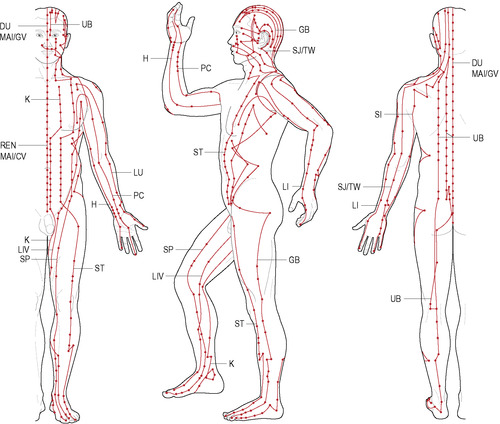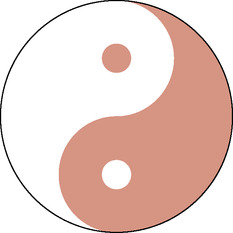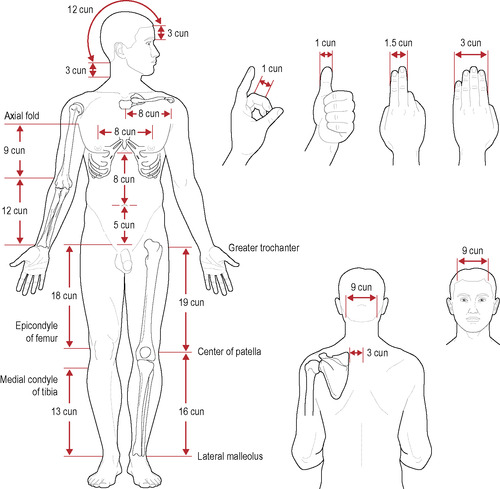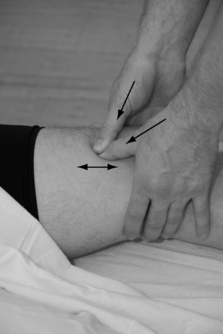9. Acupressure and Tui Na in sports massage
According to Asian philosophy, Qi (literally “air, breath”) is the circulating life force without which all living things cannot exist. It pervades all living beings, including the human body, and when it is circulating in a natural way, health is the prevalent state. Qi circulates in specific pathways named channels and collaterals, together often referred to as “meridians,” which form layers of energy that permeate the body. Major points of access to this energy flow are called “acupuncture points,” or “acupoints,” and are divided into three basic groups:
1. Regular acupoints. These acupoints are located bilaterally on the 12 regular channels, and individually on the “extraordinary channels” Du Mai and Ren Mai, which run on the anterior and posterior midline of the body (Fig. 9.1).
 |
| Figure 9.1 |
2. Extraordinary points. These points have distinct names and locations not always immediately associated with the regular channels. Even though they are situated in many different areas of the body, they are still related to the meridian system, and are commonly used to treat specific conditions.
3. Ah Shi points. Local acupoints, tender upon pressure, which are often used during treatment of different pain syndromes.
Acupuncture channels (Fig. 9.1)
The acupoints have distinctly uniform locations, given through a combination of anatomical landmarks and the personally adapted measurement units called “cun.” The cun units are measured from the treated athlete’s body.
Examples of cun measurements (Fig. 9.2)
Head
Chest and abdomen
• Between two nipples: 8cun.
• Tip of xiphoid process to center of umbilicus: 8cun.
• Center of umbilicus to superior ramus of the pubic bone: 5cun.
Back
• Between the two medial borders of the scapulae: 6cun.
• Medial border of scapulae to center of the spinous process of same-level thoracic vertebrae: 3cun.
Upper extremities
• End of the axillary fold to the transverse cubital crease: 9cun.
• Transverse cubital crease to the transverse wrist crease: 12cun.
• Distance between four fingers (excluding the thumb): 3cun.
• Width of thumb at the interphalangeal joint: 1cun.
Lower extremities
• Greater trochanter to the middle of patella: 19cun.
• Center of patella to tip of lateral malleolus: 16cun.
• Superior ramus of the pubic bone to the superior border of the medial femoral epicondyle ridge: 18cun.
• Inferior border of the tibial condyle to the tip of medial malleolus: 13cun.
• Lateral malleolus to lateral edge of the heel: 3cun.
According to more recent research, the energy channels are commonly found to be located adjacent to larger fascias. A high correlation between fascial formations and the meridian-based channel system was discovered when scanning connective tissue structures in the human body and further combining them with the traditional meridian system and acupoints (Huang et al. 2006). The channels can also be mapped through refined measurement methods of skin impedance (Hu et al. 1993).
Stimulation of the body’s energetic system through needles, heat, electricity, and manual pressure has long been part of the Asian medical tradition. Studies have indicated that acupuncture can significantly increase maximum performance capacity and physical performance at the anaerobic threshold (Ehrlich & Haber 1992), and that electrical acupoint stimulation can enhance athletes’ rapid strength (Yang et al. 2006). The application of pressure on acupoints using fingers, elbows, or specific tools can be a great supplement to sports massage therapy. Manual stimulation of acupuncture points is often referred to as acupressure, and can be beneficially combined with Chinese manual therapy forms like Tui Na (i.e., push-grasp.) or the Japanese equivalent, Shiatsu.
It has been shown that manual pressure on acupuncture points can substantially influence the cardiovascular system (Felhendler & Lisander 1999). Research has also found that acupressure can be another useful treatment method for reducing low back pain, including when combined with aromatic essential lavender oil treatment (Hsieh, 2004 and Yip and Tse, 2004).
Yin–yang
A well-known concept of balance and change of all material and energetic manifestations is the symbol of yin–yang (Chengnan 1993) (Fig. 9.3). This is the principle of “heaven and earth” that is the guiding force of all existing things: two opposing forces that are mutually dependent. Yet in spite of their opposing nature, yin contains a part of yang within itself, as yang contains a piece of yin, as they constantly transform into one another. Yin–yang can be described as two sides of the same coin, where one is equally vital to the existence of the other. Yin is often described as “the shady side of the hill” whereas yang is accordingly depicted as “the sunny side of the hill” (Box 9.1).
 |
| Figure 9.3 |
Box 9.1
| Yin | Yang |
|---|---|
| Cold | Warm |
| Night | Day |
| Shadow | Sunshine |
| Slow | Fast |
| Wet | Dry |
| Resting | Active |
| Large | Small |
The symbol of yin–yang illustrates in an ingenious way the reality of constant change affecting all things in the universe, from the absolutely smallest to the very largest. Health is maintained through keeping a state of balance throughout life rather than striving for a more static or permanent condition. A static condition would only cause stagnation, which according to Asian medicine is a major cause of pathological conditions and should be avoided at all cost. Working with the energy system of the body, releasing blockages through stimulation of the energy channels and acupoints, is therefore an excellent tool to assist balance and the free flow of Qi.
Sports massage treatments are often applied along the concept of yin–yang. For an athlete that is too nervous and mentally overactive before a competitive event (dominant yang), a slower yin-based preevent massage treatment is used to help balance the mental and physical state. For an athlete that is too relaxed (dominant yin) and not yet in the desired mental peak state, a brisker and faster yang-based massage treatment would be used for stimulation.
Acupressure
Actively stimulating acupoints with either digital or elbow pressure can release energetic blocks in the channels. Acupressure is performed by either pressing or massaging on selected acupoints chosen for their specific effects (regular and extra points), tenderness (Ah Shi points), or where increased tissue tension is noted. According to Asian medicine, pain is created through stagnation of Qi and Blood. A dull, aching pain is considered to be more Qi-based whereas a sharper, more intense pain results from added Blood stagnation. By resolving energetic and circulatory blockages through acupressure, Qi and Blood can flow more freely and tension, pain, or dysfunction is reduced (Hsieh et al. 2004).
Digital pressure
The most common method of applying acupressure is through digital pressure. This is performed with braced thumbs, or long or index fingers, and is applied to selected acupoints during the treatment. The pressure is directed either straight into the point with gradually increased intensity, or as a focalized circular massage. Pressure with longitudinal local massage along the treated channel, crossing acupoints during the stroke, is also an effective technique to reduce stagnation.
Thumb pressure with simultaneous massage along the channels (Fig. 9.4)
The soft tissue is massaged with short strokes, back and forth along the affected energy channels, while simultaneously crossing local acupoints. All the channels in the region of tension or pain are treated to support an unrestricted flow of Qi and Blood.
Tui Na
While acupressure is generally performed by manually stimulating acupoints through direct pressure or focal massage, Tui Na also encompass a wide range of strokes and body movements. Both acupressure and Tui Na can treat a multitude of physical ailments, but for the sports massage therapist, soft tissue dysfunction is the primary focus here. The treated tissue is pushed, grasped, stretched, compressed, etc., in combination with manual acupoint stimulation, to effectively alleviate the condition. Even though Tui Na often has a strong execution, an emphasis is placed on not overstimulating the body (Xiangcai 2002).
< div class='tao-gold-member'>
Only gold members can continue reading. Log In or Register to continue
Stay updated, free articles. Join our Telegram channel

Full access? Get Clinical Tree










